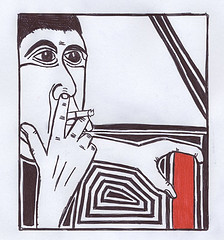To me (agile) software development is about delivering business value to the customer (by as little software as possible), and doing what works in practice. Today I’m writing a bit about routine versus variable cultures in organisations.
A current project, recent writings by Marc Evers and Nynke Fokma and upcoming sessions on organizational cultural patterns (based on Gerald Weinberg’s work) inspire me to write a little about… routine  , so I can explain what the session is about, and evolve my understanding beyond what’s in the book. I’ve been using variations of this model for quite a while now, so it is about time to write about it
, so I can explain what the session is about, and evolve my understanding beyond what’s in the book. I’ve been using variations of this model for quite a while now, so it is about time to write about it 
My mentoring/coaching clients fall roughly in two categories: those doing some form of chaos development, and those who supposedly have a bureaucratic, routine based process.
Digging deeper, my clients fall into one category: those who have some form of chaos development…
I’ll explain my digging along two lines:
- Routine processes are uninteresting strategically
- Routine processes are not focused on results. They only (seem to) work, because result-oriented people find a way to work around it and don’t tell anybody…
- Routine is boring
Routine software development culture :
“We are developing software – follow The Rules”
Routine processes are uninteresting strategically
As Marc Evers writes in Keep on failing (in the small…):
“Predictable projects are not interesting, not in a strategic sense. If it’s predictable, there’s probably someone who has already done it or even created a product or service for it. Most interesting, strategic IT projects are in the complex space, where cause and effect are only coherent in retrospect and do not repeat. Best practices, recipes and step-by-step methods don’t work here. You need to steer based on feedback instead, through a cycle of probe, sense, respond”

So, if you want to create an entirely new market, you have to work based on feedback, if you want to go somewhere with an innovative product, you have to dance to the beat of life, and create your own beats 
Routine processes are not focused on results
Because, to get anything done in a routine environment, you have to bend the rules. “The Rules” are usually made to prevent change of any kind, and “The Rules” have a tendency to grow in volume. As they grow in volume, they inevitably start to contradict themselves. Therefore, my clients only fall into one category 
Now, as an investor or product owner, if you start a new project, you might feel tempted by the false idol of “The Rules”. It is easy to find IT suppliers who happily work with “The Rules”, making big, fixed-price contracts and maybe even using some form of Model Driven Architecture / Design, which is a translation of working by “The Rules” in software development terms. . .
As Nynke Fokma writes in Great innovations that help the world
“The intention of MDD, model and routine driven developments, is to make software work routine. It is a focus on the tool rather than on people”
So, why do routine-oriented people get scared when you mention agile. They hear a transformation from:
“We are developing software – follow The Rules”
to:
“We are developing software”,
which would be a Variable culture.
The mental image of a Variable culture for someone in a Routine culture looks like this:

“Variable Expansion”
If you remove “Follow the Rules”, Routine people can’t see the safety net. A Variable culture doesn’t have a safety net, so we don’t want to go there from routine.
However, as a mentor, a Variable culture is a much more pleasant state to start than a Routine culture – there are no “The Rules” to unlearn…
People in a variable organisation know that they are developing software, which makes them more aware than people in an oblivious culture:
“Are we developing software, really?”
“Oh, no, this is not software, It’s just some macro’s I made in Excel and Access” (never mind that these macro’s are the only things that are keeping track of millions of euros worth of business, as I saw in a moderately large manufacturer).
Clients in the variable space are usually a lot of fun for me. They are results oriented, and often have delivered software recently. They know they are developing software, they hire me to do better.
Usually, when they get to the point to hire a mentor or go for training, they know they have a bit too much chaos development. They already have some areas for improvement in mind, maybe some practices too, and with some creative questions, maybe a small retrospective, we collectively find some more.
We keep the results focus and the fun people are having at work, and add just enough process to make the team(s) more productive (deliver less defects, more business value).
What that looks like? I’ll leave that for an upcoming post…. There are loose ends here, some intentionally…
I’m not saying you don’t need any _routines_, which is differently from having a routine culture. Appropriate routines create a stable basis on which you can build and experiment. On the other hand, as nynke says: if you are in control, you are not going fast enough…
Credits:
The beat of life photo by ♥ Cherie ♥
“Variable Expansion” photo by Andreas Kollegger.
Gerald Weinberg, for his work on organisational cultural patterns
Nynke Fokma and Marc Evers for blog entries and discussions.
 I’m not a big fan of certification, for various reasons. And now I’ve added another reason:
I’m not a big fan of certification, for various reasons. And now I’ve added another reason:![]() It seems employers are doing the same….
It seems employers are doing the same….


 For some reason this second programmer sees the install script as a
For some reason this second programmer sees the install script as a


